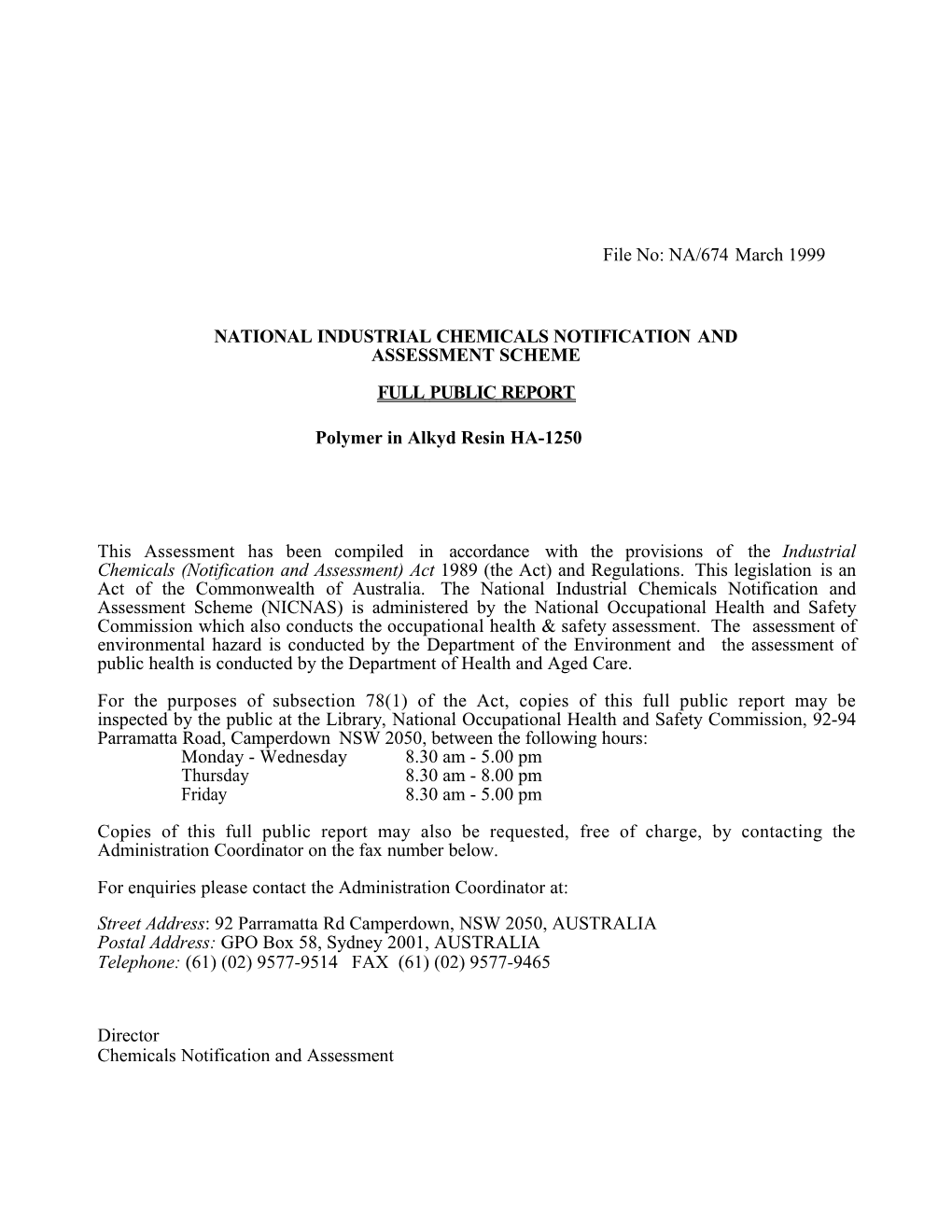FileNo:NA/674March1999
NATIONALINDUSTRIALCHEMICALSNOTIFICATIONANDASSESSMENTSCHEME
FULLPUBLICREPORT
PolymerinAlkyd ResinHA-1250
ThisAssessmenthasbeencompiledinaccordancewiththeprovisionsoftheIndustrialChemicals(NotificationandAssessment)Act1989(theAct)andRegulations.ThislegislationisanActoftheCommonwealthofAustralia.TheNationalIndustrialChemicalsNotificationandAssessmentScheme(NICNAS)isadministeredbytheNationalOccupationalHealthandSafetyCommissionwhich alsoconductstheoccupationalhealth safety assessment.TheassessmentofenvironmentalhazardisconductedbytheDepartmentoftheEnvironmentandtheassessmentofpublichealthisconductedbytheDepartmentofHealthandAgedCare.
Forthepurposesofsubsection78(1)oftheAct,copiesofthisfullpublicreportmaybeinspectedbythepublicattheLibrary,NationalOccupationalHealthandSafetyCommission,92-94ParramattaRoad,CamperdownNSW2050,betweenthefollowinghours:
Monday-Wednesday8.30am-5.00pmThursday8.30am-8.00pm
Friday8.30am-5.00pm
Copiesofthisfullpublicreportmayalsoberequested,freeofcharge,bycontactingtheAdministrationCoordinatoronthefaxnumberbelow.
ForenquiriespleasecontacttheAdministrationCoordinatorat:
StreetAddress:92ParramattaRdCamperdown,NSW2050,AUSTRALIA
PostalAddress:GPO Box58, Sydney2001, AUSTRALIA
Telephone:(61)(02)9577-9514 FAX(61)(02)9577-9465
Director
ChemicalsNotificationandAssessment
NA/674
FULLPUBLICREPORT
PolymerinAlkyd ResinHA-1250
1.APPLICANT
PPG IndustriesAustraliaPtyLtd of McNaughtonRoadCLAYTON VIC3168 has submitteda limited notificationstatementin supportof their applicationfor anassessment certificateforPolymerinAlkydResinHA-1250.
2.IDENTITYOFTHECHEMICAL
Thechemicalname,othername,CASnumber,molecularandstructuralformulae,molecularweight,spectraldata,detailsofthepolymercomposition,purity,impurities,andadditive/adjuvantsbeen exemptedfrompublicationintheFullPublicReportandtheSummaryReport.
TradeName:Alkyd Resin HA-1250
Number-Average
MolecularWeight(NAMW): 1000
Thenotifiedpolymerisinasolutionofsolventscomprisingxylene,n-butylalcoholandotheraromatichydrocarbons.
3.PHYSICALANDCHEMICALPROPERTIES
PhysicalandchemicaldatawerederivedfromAlkydResinHA-1250,theproductcontainingthenotifiedpolymerat60%,asthepolymerisnotisolatedfromitssolventsolution.
Appearance at 20°C
and101.3 kPa:colourlessviscousliquid
BoilingPoint:138-143C-seecommentbelow
SpecificGravity:1.05(1.17calculatedforpurepolymer)
VapourPressure:1kPa(solventcomponent)-seecommentbelow
WaterSolubility:notdetermined-seecommentbelow
PartitionCo-efficient
(n-octanol/water):notdetermined-seecommentbelow
HydrolysisasaFunction
ofpH:notdetermined-seecommentbelowAdsorption/Desorption: notdetermined-seecommentbelowDissociationConstant: notdetermined-seecommentbelowParticleSize: notapplicable
FlashPoint:37°C(solvent)
FlammabilityLimits:0.8-7%(solvent)AutoignitionTemperature:1-7°C(solvent)ExplosiveProperties: expectedtobestable
Reactivity/Stability:stable
CommentsonPhysico-ChemicalProperties
Thepolymerisneverisolatedasadefinedentitysodatagivenwasforthe60%solutionofthepolymerinsolvent.
Thenotifierclaimsthatbyanalogywithsimilar polymers,thepolymerisnotexpectedtobevolatileundertheconditionsofuse.Thepolymersolutionisalsoexpectedtoboilatthetemperature ofthesolvent,whilethevapourpressureofthepolymerispredictedtobe lowwith thevaluegivenabovethatofthe solvent.The water solubility was notdetermined,butthenotifierstatesthatthe polymeris expectedto beof lowsolubilitysinceit isnon-ionic,ofhighmolecularweightandcontainsahighlevelofaliphaticandhydrophobicgroups.Nodissociation constant datawasprovidedas the notifierclaims that the polymer hasno unitslikelytodissociate.
The polymercontains esterlinkageswhich could be expected to undergohydrolysisunderextremepHconditions.However,duetotheverylowwater solubility,thisisunlikelyintheenvironmentalpHrangeofbetween4and9.
Thedeterminationofpartitioncoefficientandadsorption/desorptioncouldnotbeundertakenasthenotifiedpolymerisexpectedtobeinsolubleinwaterandwilllargelypartitioninton-octanolratherthanwater.Due toitsverylowwater solubility, the polymerisexpectedtobecomeassociatedwiththeorganiccomponentofsoilsandsediments.Sinceitisof highmolecularweightitisnotexpectedtocrossbiologicalmembranesandwillnotbioaccumulate.
Thepolymersolutionisflammableduetothesolventcontent. ItisaClass3DangerousGood.
4.PURITYOFTHECHEMICAL
DegreeofPurity: / highAdditives/Adjuvants:
Additives / CAS Number / % Weight
xylene / 1330-20-7 / 10-29
aromatichydrocarbonsolvent / 64742-95-6 / 10-29
n-butylalcohol / 71-36-3 / 1-9
Degradation Products:stableundernormalconditionsofuse.
LossofMonomers,Additives,Impurities:
solventsmaybegraduallylostfromthesolventsolution,however,nolossofmonomerswilloccur
5.USE,VOLUMEANDFORMULATION
Thenotifiedpolymerisacomponentofpaintwhichwillbeappliedtomotorvehicles.
ThenotifiedpolymerwillinitiallybeimportedinsolutionfromEuropein paintproductcontainingupto30%ofpolymer.Itisexpectedthatafter2yearsthepolymersolution(a60%solutioninamixtureofsolvents)willbeeitherbeimportedfromEuropeormanufactured at the notifier’sresinplantin Australia. Itis expectedthat beyondyear2, upto80%ofthepolymerwillbeexportedaspaint.Estimatedimport/manufacturevolumesforthenotifiedpolymerwillbe1tonneinyear1and10-20tonnesduringyears2-5.
6.OCCUPATIONALEXPOSURE
Pre-preparedpaints containing the notified polymer willbe imported in 3.5, 4,15 and 20Ltinplatecans.Thenotifierhasprovidednodetailonthetypeofpackagingfortheoverallshipment ofimportedindividualcontainersorthehandlinginvolvedinbreakinguptheshipment intoindividualcontainersfordispatchtothecustomersites.Theindividualproductcontainersarenotexpectedtobeopenedbeforearrivalattheendusesiteandthatthelikelihoodofaspillislow.
Thepolymersolution,AlkydResinHA-1250,willinitiallybeimportedin200Lsteeldrums. Atalaterdate,thispolymersolutionmay belocallymanufacturedthen transferredforreformulationin200Lsteeldrums.
Waterfront,transportandwarehouse workers arenotexpectedtobe exposed tothenotifiedpolymerexceptinthecaseofanaccidentinvolvingspillageofthepaintorresinsolution.
Thelaboratory development, polymer manufactureandreformulationintocoatings,alongwiththewarehousestorage,willallbecarriedoutatasinglesitewithinAustralia.
Forallscenarios, skincontaminationwillbethemainroute ofexposuretothenotifiedpolymer.Duringhandlingofthepolymertothenotifiedsolution,thegenerationofmistsleading to possible inhalational exposure is unlikelydue to the highlyviscous nature ofthepolymersolution.However,inhalationalexposuremayoccurduringspraypainting.
LaboratoryDevelopment
Thenotifierindicatedthat6laboratoryworkerswouldbeinvolvedintrialsforthemanufactureofthepolymerandthemanufactureandtestingofpaint.Thepotentialexposurewouldbeforupto8hoursperday,for10to20daysperyear.Exposurewouldbebyskincontactduringthehandlingofsmallquantitiesofthepolymersolutionandpaint.Theuseofappropriatelaboratoryventilationfacilitiesandpersonalprotectiveequipmentsuchaslaboratorycoatandsafetyglasseswouldbeexpected.
PolymerManufacture
Thepolymermanufacture,whencommenced,willinvolve9workersforupto8hoursperday, 10 days peryear.Thereactants and solventswill beadded toanenclosed reactor, andthe resultantpolymer solutionwillbefiltered andfilled into 200L steeldrums. During thefilling process, there is potential for dermal exposure to thepolymer solutionin theform ofdripsandspills.Asthepolymer solutionwillbeviscous,theformationofaerosolsisunlikely.
Thefillingwillbecarriedoutunderlocalexhaustventilationtopreventexposuretothesolvents.Workerswillwearimperviousgloves,coverallsandgoggles,with additionalpersonalprotectiveequipmentbeingusedasrequired.
Reformulation(PaintManufacture)
Thereformulationofpolymersolutionintopaintcomponents,whencommenced,willinvolve9workersforupto8hoursperday,30daysperyear.Threegroupsofworkerswillbeinvolvedintheprocess:paintmixing,qualitycontrolanddrumorcanfilling.Themixersusedforpreparingthepaintwillbeenclosedandfittedwithlocalexhaustventilation.Dermalexposureto thepolymer will bepossible at several pointsthroughouttheprocess;chargingthepolymersolutionintothemixer,removalandtestingofqualitycontrolsamples,anddrips and spillsduring thepaint filtrationand filling.The formationof aerosolsduring the highspeedmixingwillbeunlikelybecauseoftheviscosityofthemixture.
Themixingandfillingwillbecarriedoutunderlocalexhaustventilationtopreventexposuretothesolvents.Workerswillwearimperviousgloves,coverallsandgoggles,withadditionalpersonalprotectiveequipmentbeingusedasrequired.
EndUse
Thenotifierestimatesthatasmanyas6000spraypaintersinupto3000establishmentsacrossAustraliacould be exposed to the notifiedpolymer.The exposure is estimated tobeforupto4hoursperday,forupto220daysperyear.
Thespray painterswho will beexposed tothenotifiedchemical will befully TAFEtrained.Typicallythespraypainterwillmeasuretheappropriateamounts ofthe differentcomponentsrequiredinaparticularformulationintoanopencontainerandpourthismixtureintoaspraygun.Thesprayingoftheautomobilewillbecarriedoutinalaminarflowdowndraftsprayboothwhichisdesignedtorapidlyremoveaerosolparticlesandsolventvapourfromtheatmosphere.Severalpossibleboothdesignsmaybeused.Inadryfloorbooth,theoverspraywillbecollectedinfilterscontainedinthe floorofthebooth; anyunremovedparticulates will reachtheexhauststack with the solvent vapours.In a wet floorbooth,overspraywillcollectinapoolofwaterbelowthegrillfloororinawetscrubberintheexhaust andwill beremoved witha filter.Theresidual solidswill bedisposed oftosecurelandfill.ThesprayboothsaresubjecttoAS/NZS/4114.1:1995SprayPaintingBooths–Design,ConstructionandTestingandAS/NZS/4114.1:1995SprayPaintingBooths–Selection,InstallationandMaintenance.Afterapplicationofthepaint,theautomobilewillbeheatedtocurethecoating.
Residual paintmixture willbewashedfrom theequipment manually, usingrecycled paintsolvent,andthewashingswillbedisposedofbysolventrecyclers.
Once residualfinal paintmixturehas dried,thenotified polymerwill be irreversiblyboundwithinthecuredmatrixandnotseparatelyavailableforeitherexposuretoworkers,orfordermalabsorption.
Spraypainterswillwear appropriatepersonalprotectiveequipmentatalltimes;imperviousglovesandanti-staticflameretardantoverallswhilemixingthepaint,and,inaddition,afullfaceshieldandrespiratorconforming toAS/NZS1715andAS/1716whileinside the spraybooth.
7.PUBLICEXPOSURE
Paintcontaining thenotifiedpolymerwillnotbeavailable tothepublic.Public exposurefromimportation,manufactureandpaintapplicationisexpectedtobenegligible.
Thegeneralpublicmaycomeincontactwiththecuredpaint,butthehighmolecularweightofthepolymerandphysico-chemicalpropertiesofthecuredcoatingwillprecludeabsorptionofthenotifiedchemicalacrossbiologicalmembranes,
8.ENVIRONMENTALEXPOSURERelease
Thereispotentialforreleaseduringthepolymermanufacture,thepaintformulationandthepaintapplication.The manufacturingandformulation processeswill take place at thePPGplantandanyspillsthatoccurwillbecontainedbytheplantbunding.Paintisappliedtomotor vehicles with approximately30% efficiency ina spraybooth with control measures,suchasafilteringsystem and maskingmaterials,inplace.Theresultingsurface coat isheatcured. Cleaningofthespraygunand mixing equipment willgeneratewastewhichwillbecollectedanddisposedofinthesamemanneraswastewaterfromthespraybooth.
Duringthemanufacturingandformulation processes,thenotifier estimatesthat upto 400kgper yearofwastepolymer wouldbegeneratedatthe PPGplant. During paintapplication itisexpectedthat700kgofpolymerwasteduringthefirstyearand2800kgofwasteduringsubsequentyearswillbeproduced.
Someresidue(2%ofthecontainercontents)willalsoremaininthe‘empty’containersafteruse.Itisestimatedthat20kginthefirstyearand80kgannuallyinsubsequentyearswillremainasresidueinthecontainers.
Fate
Thepolymer,aspartoftheautomotivesurfacecoating,willsharethefateofthevehiclepanel,potentiallybeingrecycledasscrap.Incinerationofthepaintfilmwouldemitnoxiousfumesincludingoxidesofcarbon.
Thesolid wastegenerated in themanufacturing,formulationandapplicationof thecoatingwillbedisposedtolandfill(althoughincinerationisanoption).Itisassumedthatthepolymerisrecoveredasaninsolublesolidfromthewastewaterusedforcleaningandalsodisposedoftolandfill.Thecontainersandtheirresiduewillalsobedisposedinthismanner.Leachingofthepolymerfromlandfillfromthesesitesisunlikely,giventhelowsolubilityofthesubstance.
Hydrolysisis theoretically possiblebecauseofthe presenceofester groups in the polymer,butisunlikelygiventhemildenvironmentalpHrange(pH4to9).Thepolymerisnotexpectedtocrossbiologicalmembranes,duetothelowsolubilityandhighmolecularweight,andassuchshouldnotbioaccumulate(Connell,1989).
9.EVALUATIONOFTOXICOLOGICALDATA
Notoxicologicaldatawereprovided.
10.ASSESSMENTOFENVIRONMENTALEFFECTS
Noecotoxicologydatawereprovided.
11.ASSESSMENTOFENVIRONMENTALHAZARD
The polymer crosslinks withother paintcomponents to forma veryhigh molecularweightandstablepaintfilmthatadheresfirmlytotheprimerlayertowhichitisapplied.Thepolymer,aspartofthissurfacecoating,willthereforesharethefateofthevehiclepanel.Thepaint film will slowlydeteriorate under the action ofUV light, but this would benegligibleoverthelifeofthemotorvehicle.Whenthevehicle panelisrecycled,thepolymerwouldbedestroyedthroughincineration.
The majority ofnotified polymerassociatedwith wastefrom theapplication of thepaint totheautomotivesurfaceshouldnotentertheenvironmentuntilitisdisposedoftolandfill.Movement of the polymer by leachingfrom landfillsites is not expectedbecause of the lowwatersolubilityandhighbindingaffinitytosoilorcross-linkinginthecuredpaint.
Intheeventofaccidentalspillageofthepolymersolutionintowaterways,thepolymerisnotexpected to disperse into the water, but settle outonto sediments. If the polymer is spilt onland,eitherduringusage ortransport,itisexpectedtobecome immobilisedinthesoil layer.Contaminatedsoilcanthenbecollectedanddisposedoftolandfill.
Giventheabove,environmentalexposureandtheoverallenvironmentalhazardisexpectedtobelow.
12.ASSESSMENTOFPUBLICANDOCCUPATIONALHEALTHANDSAFETYEFFECTS
Thenotifiedpolymerhasahighmolecularweightandisunlikelytocrossbiologicalmembranesandcauselocalorsystemichealtheffects.Thelevelofindividualresidualmonomers is low.Thelevel oflow molecular weightspeciesishighandthe toxicologicalhazardsoftheselowmolecularspecieswerenotinvestigatedbythenotifier.However,when embeddedin thecuredpaint coatingon motorvehiclestheyareunlikely to be bioavailable.Onthelimitedavailabledata,thenotifiedpolymerwouldnotbeclassifiedasahazardoussubstanceaccordingtotheNOHSCApprovedCriteriaforClassifyingHazardousSubstances(NationalOccupationalHealthandSafetyCommission,1994a).
Thepolymer solutionAlkyd ResinHA-1250, aSchedule 5poison accordingto theMSDS, isahazardoussubstanceanddangerousgood(flammableliquid)becauseofpresenceofxylene.TheMSDSforthepolymersolutionlistsanumberofpotentialhealtheffects,namelynausea,vomiting,skin,eyeandrespiratoryirritation,centralnervoussystemdepressionandchroniccentralnervoussystem disorders.Theserelatetothesolvents,ratherthanthenotifiedpolymer. The notifier is responsible for ensuring that Alkyd Resin HA-1250 is
appropriatelylabelled,aspertheNOHSCNational Codeof practicefortheLabellingofWorkplaceSubstances(NationalOccupationalHealthandSafetyCommission,1994b).
OccupationalHealthandSafety
There is little potentialfor significantoccupational exposure to thenotifiedpolymer in thetransportandstorageofthe paintcomponentscontainingthispolymer.Therewillbeexposureduringthemanufactureandreformulationofthepolymer,duringthelocalproductionofthepaintcomponents,andintheuseanddisposalofthepaints.
Duringthemanufactureandreformulationprocesses,themainexposurerouteforthenotifiedpolymerwill bedermal.Thepaintsandpolymer solutions will beviscous,andformationofaerosolsisnotexpected.Thepolymerisnotexpectedtobehazardousbydermalexposureas thehighmolecularweightwillprecludeabsorptionthroughtheskin.Protectivemeasuresusedto prevent exposure tothe hazardous solventsshouldprovide sufficientprotection againstthenotifiedchemical.
Thefinalpaintmix,includingthepre-preparedpaintcontainingthenotifiedpolymer,couldcontainawidevarietyofadditionalingredientsoncefullymixed.Thisislikelytointroducehumanhealthhazardsbecause,apartfromarangeofpotentiallytoxicsolvents,otherhazardingredientsmay be present.The spraying procedurealso producesadense aerosol of paintparticleswhichwouldadverselyaffecthumanhealthevenintheabsenceofadditionalhazardouscomponents.It is alsoprobablethatprofessionalsinvolved in thespraypaintingindustrywilluseanumberofdifferentpaintformulations.
Forthese reasons, thenotified polymer mustbe assessedfor the contributionit makes tothehazardsassociated withuseofthespraypaints. Thepresenceofmanypotentialand actualhazardoussubstancesintheformulationsrequirestheuseofstringentengineeringcontrols,suchasacorrectlyconstructed andmaintained spraybooth,andofahighlevelof personalprotectiveequipment,suchasimpermeableoverallsandglovesandafullfaceshieldandrespirator.TheuseofthepaintcontainingthenotifiedpolymershouldbeinaccordancewiththeNOHSCDraftNationalCodeofPracticeforSprayPainting(NationalOccupationalHealthandSafetyCommission,1991).Thelevelofprotectionfromexposureaffordedbythestandardprotective measures willprovide adequate protection fromthenotifiedpolymer,whichislikelytobelessintrinsicallytoxicthanmostofthesolvents,pigmentsandotheringredients.
Oncetheappliedfinal paintmixhashardened, thepolymerwillnot be separately availableforexposureorabsorption.
ThereareNOHSCexposurestandardsforn-butylalcoholandxylene,identifiedasingredientsinAlkydResinHA-1250.Theemployerisresponsibleforensuringthattheseexposurestandards,andexposurestandardspertainingtoother finalpaintmixadditives,arenotexceededintheworkplace.
The paint componentscontaining the notifiedpolymer areflammableduetotheir solventcontent.Precautionsmustbetakentoavoidsourcesofignition,e.g.useofearthing leads.Operatorsshouldwearantistaticoverallsandfootwear.
Similarconsiderationsapplyinthedisposalof the polymer.The wastes containingthenotifiedpolymermaybehazardoussubstancesonthebasisofthesolventandotherresincontent,andtheprecautionsusedonthebasisoftheseadditionalmaterialsshouldbeadequatefor protection fromthe notified polymer.In addition, muchof the polymerwill becrosslinked,hardenedandimmobilisedbythetimeofdisposal.
PublicHealth
Thenotifiedpolymerorpaintcontainingthepolymerwillnotbeavailabletothepublic.Negligiblepublicexposureisanticipatedfrommanufacture,reformulationorpaintapplication.Publiccontactwiththecuredpaintonmotorvehiclebodiesmayoccur;however,thehighmolecularweightofthenotifiedpolymer,theadhesionofpainttothesubstrateandthephysico-chemicalpropertiesofthecuredcoatingwillprecludeabsorptionofthenotifiedpolymeracrossbiologicalmembranes.Intheeventofaccidentalspillage,adequateclean-upprocedures areprovidedintheMSDS.Basedonitsusepattern andphysico-chemicalcharacteristics,thenotifiedchemicalwillnotposeasignificanthazardtopublichealthwhenusedintheproposedmanner.
13.RECOMMENDATIONS
To minimiseoccupationalexposure tothe Polymer inAlkyd Resin HA-1250the followingguidelinesandprecautionsshouldbeobserved:
- Employersshould ensurethatNOHSC exposurestandards forallof thecomponentsofthefinalpaintmixarenotexceededintheworkplace;
- Safetygogglesshould beselectedandfitted inaccordancewithAustralianStandard(AS)1336(StandardsAustralia,1994)tocomplywithAustralian/NewZealandStandard(AS/NZS)1337(StandardsAustralia/StandardsNewZealand,1992);
- IndustrialclothingshouldconformtothespecificationsdetailedinAS2919(StandardsAustralia,1987)andAS3765.2(StandardsAustralia,1990);
- ImpermeableglovesormittensshouldconformtoAS2161(StandardsAustralia/StandardsNewZealand,1998);
- AlloccupationalfootwearshouldconformtoAS/NZS2210(StandardsAustralia/StandardsNewZealand,1994b);
- RespiratorshouldconformtoAS/NZS1715(StandardsAustralia/StandardsNewZealand,1994a);
- Spillage of thenotified chemicalshould be avoided.Spillages should be cleaneduppromptlywithabsorbentswhichshouldthenbeputintocontainersfordisposal;
- Goodpersonalhygieneshouldbepractisedtominimisethepotentialforingestion;
- AcopyoftheMSDSshouldbeeasilyaccessibletoemployees.
14.MATERIALSAFETYDATASHEET
TheMSDSforthenotifiedchemical wasprovidedinaformatconsistent withtheNationalCodeofPracticeforthePreparationofMaterialSafetyDataSheets(NationalOccupationalHealthandSafetyCommission,1994c).
ThisMSDSwasprovidedbytheapplicantaspartofthenotificationstatement.Itisreproducedhere asamatter of public record.The accuracy of thisinformationremains theresponsibilityoftheapplicant.
15.REQUIREMENTSFORSECONDARYNOTIFICATION
Underthe Act, secondarynotificationofthenotifiedchemicalshall berequiredifanyofthecircumstancesstipulatedundersubsection64(2)oftheActarise.Nootherspecificconditionsareprescribed.
16.REFERENCES
ConnellDW(1989)Generalcharacteristicsoforganiccompoundswhichexhibitbioaccumulation.In:D.W.Connelled.Bioaccumulation ofXenobioticCompounds.CRCPress,BocaRaton.
NationalOccupationalHealthandSafetyCommission(1991)DraftNationalCodeofPracticeforSprayPainting.Canberra,AustralianGovernmentPublishingService.
NationalOccupationalHealthandSafetyCommission(1994a)ApprovedCriteriaforClassifyingHazardousSubstances[NOHSC:1008(1994)].Canberra,AustralianGovernmentPublishingService.
NationalOccupationalHealthandSafetyCommission(1994b)NationalCodeofPracticefortheLabellingofWorkplace Substances[NOHSC:2012(1994)].Canberra,AustralianGovernmentPublishingService.
NationalOccupationalHealthandSafetyCommission(1994c)NationalCodeofPracticeforthePreparation ofMaterial SafetyDataSheets[NOHSC:2011(1994)].Canberra,AustralianGovernmentPublishingService.
StandardsAustralia(1987)AustralianStandard2919-1987,IndustrialClothing.Sydney,StandardsAssociationofAustralia.
StandardsAustralia(1990)AustralianStandard3765.1-1990,ClothingforProtectionagainstHazardousChemicalsPart1ProtectionagainstGeneralorSpecificChemicals.Sydney,StandardsAssociationofAustralia.
StandardsAustralia (1994)Australian Standard1336-1994,Eyeprotection intheIndustrialEnvironment.Sydney,StandardsAssociationofAustralia.
StandardsAustralia/StandardsNewZealand(1992)Australian/NewZealandStandard1337-1992,EyeProtectorsforIndustrialApplications.Sydney/Wellington,StandardsAssociationofAustralia/StandardsAssociationofNewZealand.
StandardsAustralia/StandardsNewZealand(1994a)Australian/NewZealandStandard1715- 1994,Selection,UseandMaintenanceofRespiratoryProtectiveDevices.Sydney/Wellington,StandardsAssociationofAustralia/StandardsAssociationofNewZealand.
StandardsAustralia/StandardsNewZealand(1994b)Australian/NewZealandStandard2210- 1994,OccupationalProtectiveFootwear.Sydney/Wellington,StandardsAssociationofAustralia/StandardsAssociationofNewZealand.
StandardsAustralia/StandardsNewZealand(1998)AS/NZS2161.2:1998Occupationalprotectivegloves,Part2:Generalrequirements,StandardsAustralia/StandardsNewZealand.
